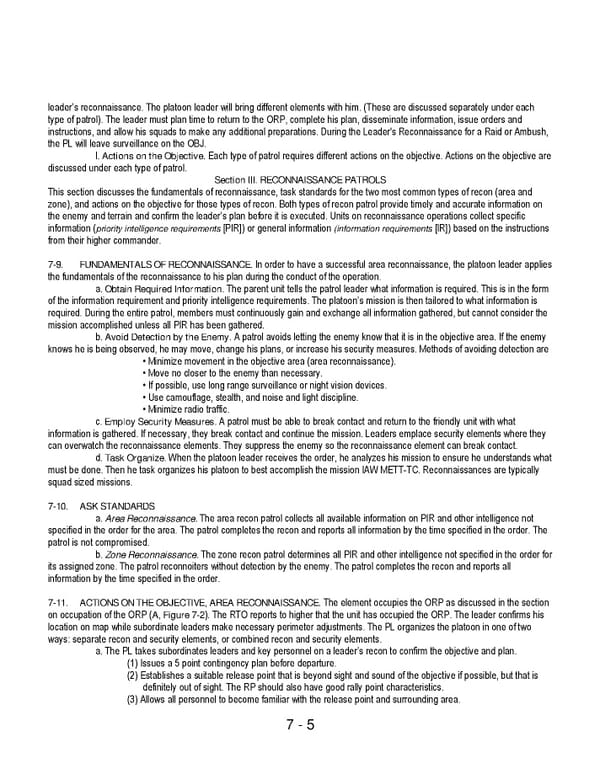7 - 5 leader’s reconnaissance. The platoon leader will bring different elements with him. (These are discussed separately under each type of patrol). The leader must plan time to return to the ORP, complete his plan, disseminate information, issue orders and instructions, and allow his squads to make any additional preparations. During the Leader's Reconnaissance for a Raid or Ambush, the PL will leave surveillance on the OBJ. l. Actions on the Objective. Each type of patrol requires different actions on the objective. Actions on the objective are discussed under each type of patrol. Section III. RECONNAISSANCE PATROLS This section discusses the fundamentals of reconnaissance, task standards for the two most common types of recon (area and zone), and actions on the objective for those types of recon. Both types of recon patrol provide timely and accurate information on the enemy and terrain and confirm the leader’s plan before it is executed. Units on reconnaissance operations collect specific information (priority intelligence requirements [PIR]) or general information (information requirements [IR]) based on the instructions from their higher commander. 7-9. FUNDAMENTALS OF RECONNAISSANCE. In order to have a successful area reconnaissance, the platoon leader applies the fundamentals of the reconnaissance to his plan during the conduct of the operation. a. Obtain Required Information. The parent unit tells the patrol leader what information is required. This is in the form of the information requirement and priority intelligence requirements. The platoon’s mission is then tailored to what information is required. During the entire patrol, members must continuously gain and exchange all information gathered, but cannot consider the mission accomplished unless all PIR has been gathered. b. Avoid Detection by the Enemy. A patrol avoids letting the enemy know that it is in the objective area. If the enemy knows he is being observed, he may move, change his plans, or increase his security measures. Methods of avoiding detection are • Minimize movement in the objective area (area reconnaissance). • Move no closer to the enemy than necessary. • If possible, use long range surveillance or night vision devices. • Use camouflage, stealth, and noise and light discipline. • Minimize radio traffic. c. Employ Security Measures. A patrol must be able to break contact and return to the friendly unit with what information is gathered. If necessary, they break contact and continue the mission. Leaders emplace security elements where they can overwatch the reconnaissance elements. They suppress the enemy so the reconnaissance element can break contact. d. Task Organize. When the platoon leader receives the order, he analyzes his mission to ensure he understands what must be done. Then he task organizes his platoon to best accomplish the mission IAW METT-TC. Reconnaissances are typically squad sized missions. 7-10. ASK STANDARDS a. Area Reconnaissance. The area recon patrol collects all available information on PIR and other intelligence not specified in the order for the area. The patrol completes the recon and reports all information by the time specified in the order. The patrol is not compromised. b. Zone Reconnaissance. The zone recon patrol determines all PIR and other intelligence not specified in the order for its assigned zone. The patrol reconnoiters without detection by the enemy. The patrol completes the recon and reports all information by the time specified in the order. 7-11. ACTIONS ON THE OBJECTIVE, AREA RECONNAISSANCE. The element occupies the ORP as discussed in the section on occupation of the ORP (A, Figure 7-2). The RTO reports to higher that the unit has occupied the ORP. The leader confirms his location on map while subordinate leaders make necessary perimeter adjustments. The PL organizes the platoon in one of two ways: separate recon and security elements, or combined recon and security elements. a. The PL takes subordinates leaders and key personnel on a leader’s recon to confirm the objective and plan. (1) Issues a 5 point contingency plan before departure. (2) Establishes a suitable release point that is beyond sight and sound of the objective if possible, but that is definitely out of sight. The RP should also have good rally point characteristics. (3) Allows all personnel to become familiar with the release point and surrounding area.
 Ranger Handbook Page 116 Page 118
Ranger Handbook Page 116 Page 118